The True Story of a Somewhat Unconventional American Life
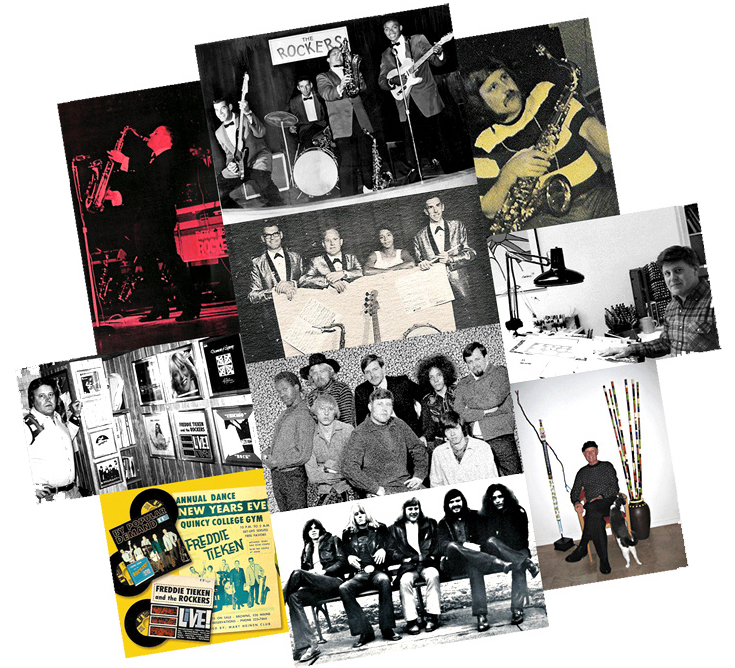
For more than five decades, Freddie Tieken’s life has centered around music and design. He has been a musician and vocalist, songwriter and arranger, recording engineer and producer, artist manager, music publisher and concert promoter. He has owned and operated three recording studios. For 16 years, he fronted his own bands, playing over 3,500 live gigs and spending thousands of hours in recording sessions.
Freddie or Fred, as he is known today, was creative director at a leading Chicago design agency before starting his own design and marketing firm. He has received more than 200 national and international awards in the fields of design, illustration, art direction, marketing and advertising. He has been featured in Graphic Design: USA magazine as an International Top 50 Art Director and has appeared in Who’s Who of Outstanding Americans.
A lot of misinformation has appeared on the Internet and in various print media over the last several years concerning Freddie Tieken and his bands. The following narrative is meant to once and for all set the record straight, in his own words, for anyone who might be interested.
See My Art
Visit my art site to see what I’m doing now!
I Was Born in a (really) Small Town
I was born Frederick Earl Tieken in 1935 during the great depression. My birthplace was a one-room shack in the Mississippi river town of Meyer, Illinois, population 100. My father Dale Tieken worked as a welder, helping to build the Meyer-Canton dam for the WPA.


Early Influences
I spent a couple of summers across the river in Canton, Missouri with my Grandma Lillie and Aunt Joy Caldwell. Grandma’s apartment was above the Canton Cinema and every Saturday night we would sit by the open window and look down on the lines of people gathering for the movies. On Saturday afternoon, Grandma would give me a quarter to go to the matinee double feature, usually featuring Hopalong Cassidy, Lash La Rue or Gene Autry. I could sit through those double features two or three times.
Next door to the theater was a honkytonk tavern and on weekends we would sit at our open window and listen to the sounds of hillbilly music and people having fun pouring out of the tavern while we ate our peanut butter and jelly sandwiches. The noise never got too loud or raucous for my Grandma.
What wonderful summers those were! It might as well have been Times Square. When I look back now I realize that this is where I developed my love of music, theaters, and the whole notion of people having a good time and being entertained.
At about that same time my parents managed to save twenty-five dollars to buy me a clarinet. I’ll never forget the first time I picked up that clarinet. By the end of the first day, I could play “Don’t Fence Me In” and “Twelfth Street Rag”. I didn’t know what sheet music was, I just listened to the radio and any old 78 RPM records I could get my hands on.
I also developed quite an interest in drawing, creating my own comic books, posters and ads for my make-believe orchestra and movie theater. I didn’t realize it at the time, but we were very poor and I remember my parents having just enough money to buy me a dozen sheets of typing paper every Saturday at the corner store. Before the week was out, I’d have every square inch of that paper covered with my drawings and paintings. My mom Tina was always my biggest supporter and she saved a lot of my early artwork.
Some of my fondest memories as I approached my high school years are the Sunday afternoons we spent at Grandma and Grandpa Tieken’s sprawling old farmhouse. After a huge dinner, we would all gather in the parlor where Dad’s entire family would rock out on the piano, banjo and juice harp with lots of vocal harmony and yours truly on the clarinet. Another favorite activity on those Sunday afternoons was a ride on Duke or Barney, my Grandpa’s plow horses.
My mom always encouraged me to play my clarinet at school and church events. She would drive me to all the local dances and by age twelve I was “sitting in” with the likes of Bo Shipe, one of the area’s most popular bandleaders.
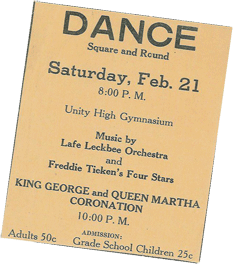
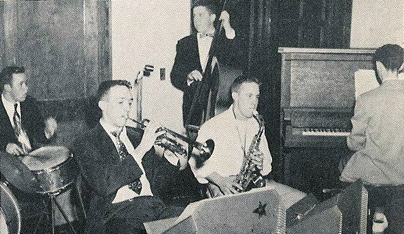
Somehow I convinced Lafe Leckbee, a square dance bandleader, to let my group play during his intermissions every weekend at the Lorraine, Illinois town hall. Before long, Leaf was gone and we had the gig. At five dollars each per night, I guess you could say this was my first professional gig.
Every summer during my high school years I was expected to plow, plant and be a good dirt farmer. I hated every minute of it and my dad considered me very lazy, but every minute I wasn’t working in the fields, I was busy drawing and playing my saxophone.
Sometimes I would work for the neighbors, bailing hay for $5.00 a day. It always seemed like it was 100° from dawn to dark, seven days a week with so much chaff in the air you could hardly breathe. And all the while those giant Mississippi River bottom mosquitoes were trying to suck all the blood out of you. The good part was that one summer I saved enough money to buy a saddle for my horse Thunder.
The absolute worst job I ever had though was working at a gas station as an attendant/tire changer on the weekend graveyard shift. When truckers called in with flat tires, I would take the wrecker out to what seemed like the middle of nowhere and fix flats and change tires on the big rigs. It seemed like it was always in the middle of an ice storm too. But at $1.00 an hour, it was really good money back then. I guess these jobs were good for me because they really motivated me want to make a living from art and music.
Bebop Comes to Meyer
Meyer, Illinois sits on the Mississippi River directly across and a short ferry ride from Canton, Missouri, home of Culver Stockton College. Some really cool jazz cats from Chicago and New York were students at the college and on Sunday afternoons the Meyer Tavern – the only place of business in Meyer – was the place to be since Missouri was dry on Sunday. These guys would bring their instruments and play bebop all day long. The audience was mostly farmers, fishermen and hunters with a few hip college students thrown into the mix. As a teen I would come in from the farm to hear the music and it was like going to heaven. It was unbelievable!
Exciting Times
By the mid-1950s I had graduated from high school and was playing a lot — bars, proms, parties and jamming with anyone who would let me sit in. My musical tastes were widening. I loved the blues and was really into the Memphis sound like Rufus & Carla Thomas and Otis Redding. The clubs up and down the river were jumping, especially the Terrace Room at the Hotel Elkton in Quincy.
Johnny, the Terrace Room manager, would hire these fabulous black jazz groups from all over the country. I’m talking about smokin’, rockin’ bands like Illinois Jacquette, Hiawatha & his Musical Tribe, and Cozy Eggleston since Quincy was a convenient layover between Chicago and the strip clubs of East St. Louis. Every Sunday afternoon brought live jam sessions and I can’t believe I had the nerve to get up there and play with those monsters. They tolerated me and did I learn a lot. It was so exciting!
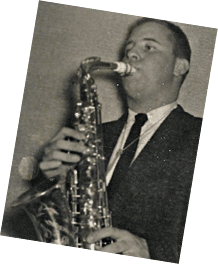
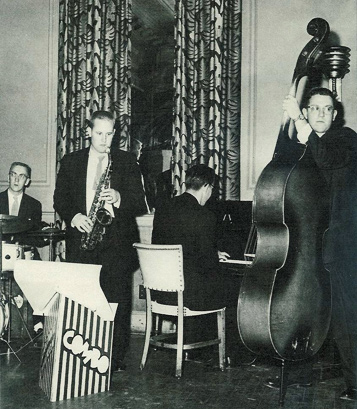
I had formed a group called The Freddie Tieken Combo and as my reputation began to grow, I was able to get the cream of the crop of area musicians for my band.
It’s hard to imagine now that I did all this while holding down a day gig. I guess that’s why I was eventually fired. I had started straight out of high school at Gardner Denver in Quincy, Illinois as an apprentice mechanical draftsman. My football coach Mr. Nelson, who was also my drafting teacher, got me the job. I learned to do perspective drawings and pen-and-ink exploded views and eventually became an illustrator and designer for the automation of assembly lines in the Detroit automotive industry. Among other things, I helped design the machine that put the big chrome strips on the sides of Ford Fairlanes as they rolled down the line.
My automotive design work meant frequent trips to Detroit where I enjoyed going downtown to Baker’s Keyboard Lounge to hear all the big names in jazz. Between the travel schedule and too many late nights with my band, I became extremely burnt out. That’s when I started neglecting my work and finally got the.axe.
I had been driving about 40 miles to Keokuk, Iowa every Wednesday night to play with a band, The Mood Notes, that my sister Janet had told me about. It paid twelve dollars a night and I liked the gig because they rocked. The band was about to break up and I asked the bass player, Mark Millspaugh, to join a band I was putting together. The year was 1955.
Freddie Vs. the Musicians’ Union
I think when rock n’ roll came along, it freaked the board members of the AFM out. They felt really threatened by rock n’ roll and rightfully so.
These guys all had boring, old-school bands of their own and, with an inside track on where all the best gigs were, they kept them for themselves. When the clubs, schools and concert hall owners starting requesting Freddie Tieken & the Rockers, they were pressured not to hire us because we weren’t union. So we joined the union and that’s when the trouble really began.
They watched me like hawks, just waiting for me to break a union rule. And that wasn’t a hard thing to do. I never was much on paper work, so I was always paying fines for filing my contracts late or not at all. I think the filing fee was $5.00 and the fine was $25.00. Anyway, their tactics didn’t work because we were playing all the gigs and the old farts from the union were sitting home.
Ironically, the secretary of the union local in Quincy, Carl Landrum, owned a music store and gave lessons. My parents had taken me there when I first started playing clarinet in grade school. After about three lessons he told my parents that I should give up music, that I just didn’t have what it takes. It must have really gotten under his skin to see me years later taking gigs away from him.
Another music store eventually opened just down the street. Its owner Gus Rieckhoff had experienced his own problems with the union. Consequently, Gus is kind of a renegade and has always enjoyed having the likes of me and my brother Dennis buying equipment and supplies from him.
Gus was smart enough to hire Gail, the person who eventually would become my wife. She was a sax teacher and also worked sales out front. Gail was an award-winning alto saxophonist whose specialty was sight reading. She would always select my reeds for me. She says we first met when I poked my head into the instruction room and made fun of her teaching a young student to read music, but I don’t remember that. Anyway, I always thought she was something else when I used to see her at the T’N’T Raceway gigs. I also remember playing at her high school when she was crowned Miss Sweetheart.
Years later after we were married and Gail started her talent agency, she had to go before Carl Landrum to apply for her AFM license. I can’t believe he gave it to her but she says she convinced him that she would bring money into the union local by making sure contracts were filed on all the dates she booked. And she did.
One time we were playing Club Laurel in Chicago when these mafia types came in, walked up to us and said, “We’ll be back in five minutes – have all your union cards on the table when we get back.” Luckily we were all standing members, and I say lucky because I had heard that in Chicago they would set fire to non-union musicians’ cars. That’s about as close to a totalitarian regime as I ever want to get.
To this day, I have never received one dime in benefits from the AFM even though I paid my dues and made them lots of money for years and years.
Get Ready to Rock
One Sunday afternoon shortly after that, Mark and I were playing at a black VFW jam session in Quincy and that’s when I first met Byron “Wild Child” Gipson. He had just come off the road with Little Richard. We hit it off so well that we decided that same night to head over to The Barn, a popular, local nightclub, and we set up our equipment. We played a couple of tunes for the owner and were hired on-the-spot. That’s the night that Freddie Tieken & The Rockers was born. The original band featured Mark Millspaugh on upright bass, Ron Davis on drums, Wild Child on vocals, piano and guitar and myself on sax and vocals. The gig at The Barn lasted well over two years and the band drew record-breaking crowds night after night.
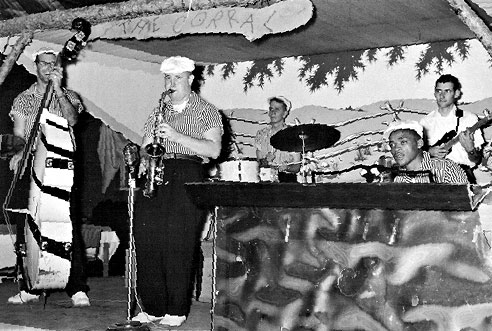
Freddy Tieken & the Rockers at The Barn nightclub, Quincy, Ill., 1956. From left: Mark Millspaugh, Freddie, Ron Davis, Wild Child Gipson and John Moorman.
If you came of age in the Midwest in the late 50s or early 60s, the chances are pretty good that you danced, strolled, bugalooed and, for the most part, partied the nights away with one of the popular rock’n’roll bands of that time period.
Let’s face it, in those days there wasn’t a rock band on every street corner, but there was a handful of bands out there making their place in Midwestern legend. One of those bands was Freddie Tieken & the Rockers and we earned our reputation by traveling through the cornfields and playing every gig we could. Night after night, we would pull up and the Rockers would roll out for another night of raucous, high intensity fun.
Mark had his upright bass painted with black and white stripes – what a showman! He would spin it around as I grabbed it. The entire band would fall to their knees and backs and spin around on the floor. It was sheer energy and we loved every minute of it. The crazier we got, the more the crowd responded. One night I failed to grab the spinning bass at the right moment and it fell off the stage and ended up a pile of splinters. That’s when Mark switched to Fender electric bass.
I would jump up and run along the top of the bar while playing my sax. Then I would jump back down and continue playing as I ran through the crowd. A long line would develop behind me and I’d lead everyone out the front door while still wailing away on my sax. We would proceed into neighboring clubs where even longer lines would form, so by the time I returned to the club where we were playing, the crowd was twice as large. I get exhausted just thinking about it now.
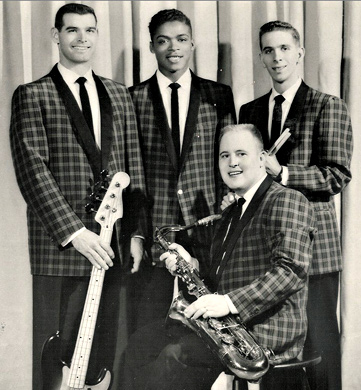
The original Freddie Tieken & the Rockers, (l to r): Mark Millspaugh, Wild Child Gipson, Ronnie Davis with Fred (seated).
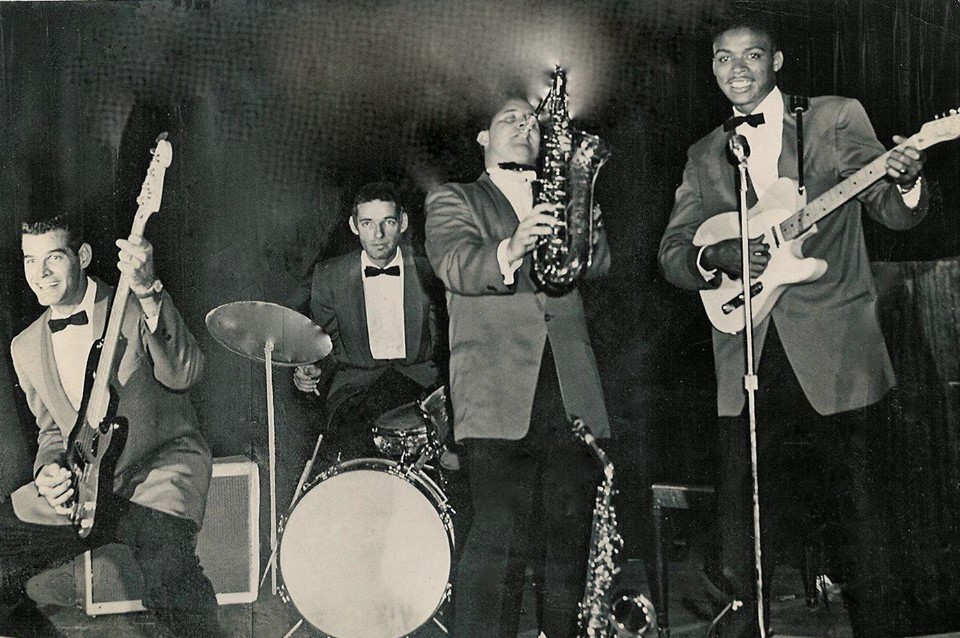
Although our fans were color blind, others were not. I’m proud that we were one of the first integrated rock’n’roll bands but back then it made things difficult. Wild Child couldn’t even stay in the same hotels as us. There was an area in each town we went where he would know people to stay with. All the big stars like Annette Funicello and Frankie Avalon that we did the TV shows with — we certainly looked different than them.
My only memories of Cicero, Illinois involve Wild Child holding off a bunch of rednecks with a gun while I went to get the car. I guess they didn’t care much for blacks in Cicero. It seems scarier than hell when I look back on it, but we just took things like that in stride and went on to the next gig.
Tales from the Road – Before I Forget
It seems like anything that could happen, happened to us in those days. I remember one night – it was our first night at a nightclub in Rock Island, Illinois. We were just getting ready to start our first set when the police came in, pulled our drummer off the stage and hauled him off to jail. He had apparently forgotten to pay his hotel bill in Quincy earlier that day. I guess the fact that he had left by the fire escape didn’t help his case.
And Wild Child, he was quite a ladies’ man. He seemed to have a different woman every night. He would sleep all day and play all night.
One night at Harold’s Club in Peoria, Illinois we were sitting around during intermission when a well dressed guy came up and introduced himself. We talked music and instruments and he invited us out for dinner at a nice restaurant. He didn’t have to ask us twice – a day off from road food sounded really good. The next day we piled into his very nice car and dined with non other than Leo Fender, founder of Fender guitars. What a great guy he was. He came back later and stayed all night listening to our group.
Speaking of Harold’s Club, we would play from 9 pm to 4 am every night and couldn’t wait for the next set. What a fun place that was. During intermission, this young comedian would do his standup routine. Years later I learned that the young comedian was Richard Pryor.
During this same time, Freddie Tieken & the Rockers released a single on Hit Records, “Sittin’ Here Cryin'” backed by “Uncle John,” both written by Wild Child. The single reached number 24 on the Billboard R&B chart. Recorded at Boulevard Studios in Chicago, John Moorman, a good friend of mine, played guitar and sponsored the session. The single was later re-released on both the Laurie and Astra labels.

At that same session, Herb Gronaeur, our booking agent, and I put together an instrumental called Big Bad Train that was later released by Tommy Dorsey.
Sittin’ Here Cryin’ received national exposure and we found ourselves touring constantly, lip synching our tunes for televised teen shows throughout the country on the same bill with Connie Francis, Jackie Wilson, Pat Boone, The Diamonds and The Big Bopper to name a few. We were part of Dick Clark’s Caravan of Stars and thousands of people would show up to these shows.
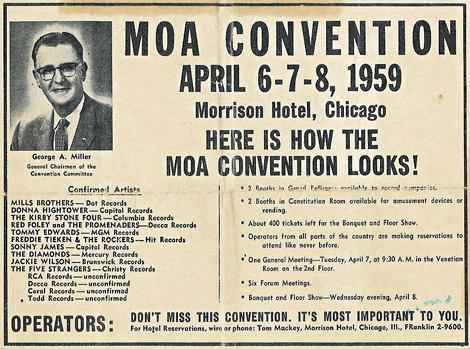
Freddie Learns about Live TV
Something really funny happened at one of the TV teen hops we played. We had been on the road all night and finally arrived at the TV studio just minutes before we were to lip sync our new single on live TV. We came in the back loading dock area while The Big Bopper was performing his hit, Chantilly Lace. There was a large screen that he sang in front of and it was backlit with a projector. I was thoroughly burnt out from traveling all night and was wondering around what I thought was backstage. I had no idea that my silhouetted image was dancing around The Big Bopper as he performed. We thought it was pretty funny but the producer didn’t laugh.
One nice thing about doing TV shows in Chicago was that everywhere we went people knew who we were. There were only a couple of local TV stations in Chicago back then. Consequently, the doormen at all the big nightclubs would recognize us and let us in. I remember one night at the Blackstone Hotel Lounge, the room was very smoky and the stage was dimly lit but I could see the silhouettes of some very interesting looking musicians. I turned to Wild Child and said, “Who is that trumpet player with his back turned to the audience?” Well, Wild Child informed me that was Miles Davis on trumpet and John Coltrane on sax. I really didn’t have a clue how cool that was at the time. I was still a country boy just getting his feet wet in the ultracool world of jazz.
What great times those were. Wild Child Gipson was one of the best friends I’ve ever had. He was a true professional, a real talent and a tremendous person.
Mr. Berry to You
It seemed like everywhere we went, there was Chuck Berry.
On our way to St. Louis from Quincy the band would stop in at the Southern Air, a restaurant Chuck owned in Wentzville. Chuck would be there, all by himself, sitting at the counter.
When the Rockers played a week at Harold’s Club in Peoria, there was Chuck sitting at the bar, all by himself, with his big yellow Cadillac convertible parked outside.
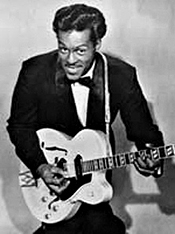 Gail booked bands at his club in Wentzville for a while. His assistant who handled the bookings for the club always referred to him as “Mr. Berry.” One of the bands Gail booked made the unfortunate mistake of introducing a cover of Elvis Presley’s Blue Suede Shoes with the statement, “Now we’re going to play a song by the king of rock n’ roll.” The band was immediately fired without pay and, although Gail offered an apology from the band and attempted to collect their pay, Chuck’s feelings must have been sufficiently hurt that he felt justified in his actions. Needless to say, Gail quit working with “Mr. Berry” after that.
Gail booked bands at his club in Wentzville for a while. His assistant who handled the bookings for the club always referred to him as “Mr. Berry.” One of the bands Gail booked made the unfortunate mistake of introducing a cover of Elvis Presley’s Blue Suede Shoes with the statement, “Now we’re going to play a song by the king of rock n’ roll.” The band was immediately fired without pay and, although Gail offered an apology from the band and attempted to collect their pay, Chuck’s feelings must have been sufficiently hurt that he felt justified in his actions. Needless to say, Gail quit working with “Mr. Berry” after that.
In all the years that I ran into the guy throughout the Midwest, I never heard him say two words to anyone.
